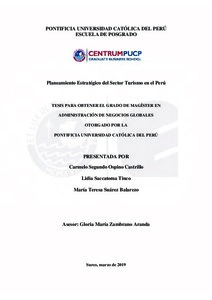Planeamiento estratégico del sector turismo en el Perú

View/
Date
2019-04-08Author
Ospino Castrillo, Carmelo Segundo
Saccatoma Tinco, Lidia
Suárez Balarezo, María Teresa
Metadata
Show full item recordAbstract
Con el objetivo de generar ventajas competitivas para el sector Turismo y aumentar sus
ingresos se desarrolló este planeamiento estratégico, utilizando el modelo secuencial del
proceso estratégico, que fue diseñado por D’Alessio (2015). Luego de analizar la situación
interna y externa del sector se determinó que para el año 2028, el Perú pasará de ser el sexto
receptor de turismo en América Latina a ser el segundo, siendo reconocido por sus sitios
históricos arqueológicos, su gastronomía y la capacidad de generar experiencias inolvidables
en los visitantes. De manera cuantitativa, los objetivos que se proponen para el año 2028
incluyen incrementar el número de visitantes de 4 millones a 10.5 millones por año, con un
gasto promedio que se incremente desde US$ 946 a US$ 3,000 como consecuencia de que se
alargan sus días de estadía y demandan más servicios durante su visita. La forma de alcanzar
esto es a través de la implementación de estrategias intensivas como el desarrollo del
segmento de turistas provenientes de China, el desarrollo del segmento de turismo
gastronómico o el ofrecimiento de paquetes completos que incluyan todos los servicios por
un precio único. Así mismo, se debe trabajar en el fomento del turismo vivencial, para dar a
conocer las culturas originarias del Perú, motivando la sostenibilidad ambiental, con la
integración de diferentes actores turísticos en clústeres, agrupados por segmentos. Lo anterior
se complementará con mejoras en la infraestructura aeroportuaria y de alojamiento. With the objective of generating competitive advantages for the Tourism Sector and
increasing its revenues, this strategic planning was developed, using the sequential model of
the strategic process, which was designed by D'Alessio (2015). After analyzing the internal
and external situation of the sector, it was determined that by the year 2028, Peru will go
from being the sixth recipient of tourism in Latin America to being the second, being
recognized by its archaeological historical sites, its gastronomy and the capacity of generate
unforgettable experiences in visitors. Quantitatively, the objectives proposed for the year
2028 include increasing the number of visitors from 4 million to 10.5 million per year, with
an average spending that increases from US$ 946 to US$ 3,000 as a result of the lengthening
of their days. of stay and demand more services during your visit. The way to achieve this is
through the implementation of intensive strategies such as the development of the segment of
tourists from China, the development of the gastronomic tourism segment or the offering of
complete packages that include all services for a single price. Likewise, it is necessary to
work in the promotion of experiential tourism, to make known the original cultures of Peru,
motivating environmental sustainability; with the integration of different touristic actors in
clusters, grouped by segments. The above will be complemented by improvements in airport
infrastructure and accommodation.
Temas
Turismo--Perú
Planificación estratégica
Planificación estratégica
Para optar el título de
Maestro en Administración de Negocios Globales
Collections
The following license files are associated with this item:





